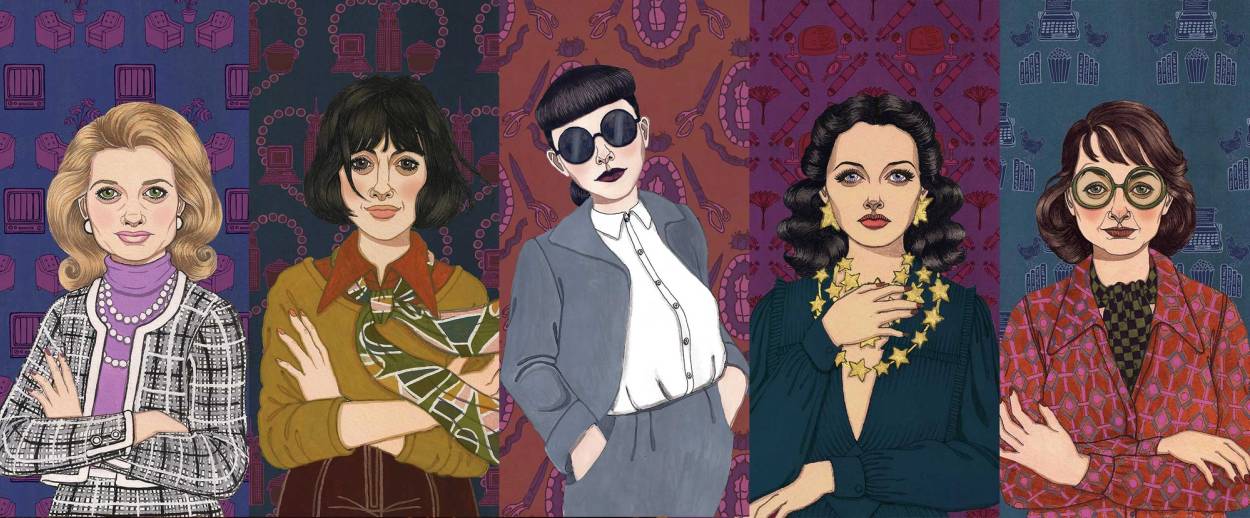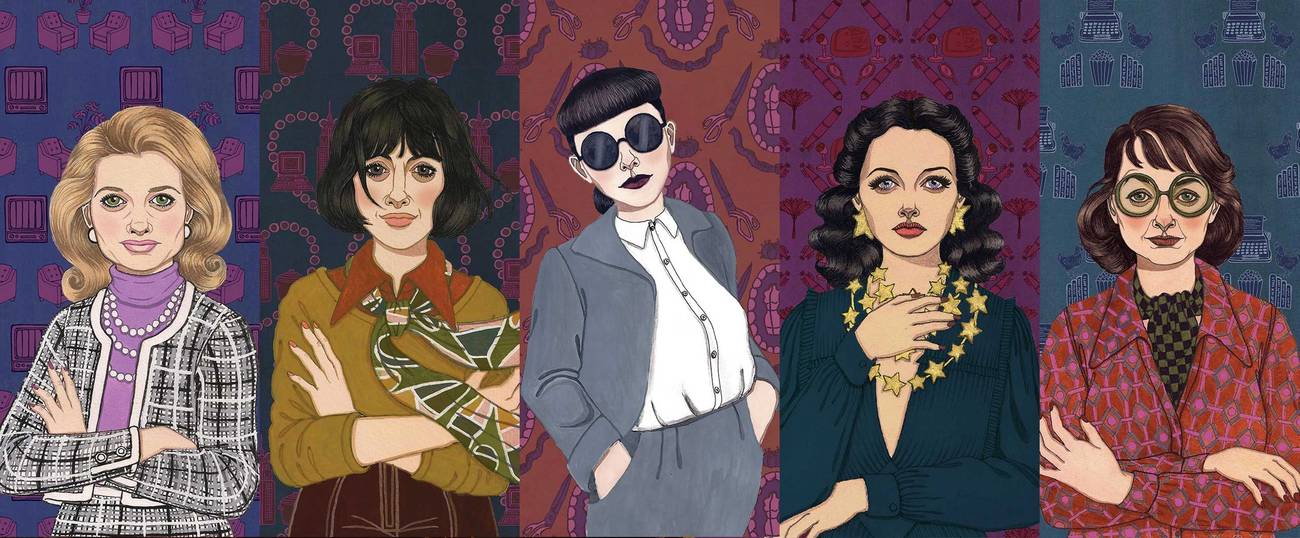Hollywood’s Missing Renegades
Yet another literary celebration of groundbreaking women gives Jews the fuzzy end of the lollipop




The recently published book Renegade Women in Film & TV by Elizabeth Weitzman serves up 50 profiles of groundbreaking women in entertainment. Each biographical sketch is accompanied by a fabulous full-page illustration of its subject by Austen Claire Clements, an up-and-coming fashion illustrator in Brooklyn. The format feels similar to a bunch of recent visually driven nonfiction roundups like Rad American Women A-Z, Herstory: 50 Women and Girls Who Shook Up the World, and Women in Science: 50 Fearless Pioneers Who Changed the World.
If you want to look at the history of trailblazing women in movies and television, you can’t ignore the fact that an outsize number were Jews. Last year’s delightful Stealing the Show: How Women Are Revolutionizing Television profiled 13 women, seven of whom were Jewish. In an interview with Tablet, the book’s author, Joy Press, was uninterested in speculating about why. But I will.
My guess is that Jewish women are wildly overrepresented in the worlds of TV and film because early Hollywood—like early comic books and recorded popular music—was a newborn, non-WASP-controlled environment in which Jews could get a foot in the door. And Jewish women were always seen as ballsy, as it were—pushy, aggressive, and smart—which was a strike against them in country clubs and fancy drawing rooms, but a blessing for early mass entertainment, which welcomed literate, funny, creative, assertive oddballs. You know, Jews.
Twelve of the 50 subjects in Renegade Women are Jews. Given that Jews constitute perhaps 2% of the population of the U.S., that’s statistically still way out of proportion—but it seems awfully low for a mass-media history. On the one hand, brava to the author for diversifying her roundup by focusing heavily on current-day pioneers like Mara Brock Akil, Ellen DeGeneres, Salma Hayek, Amy Poehler, Shonda Rhimes, Laverne Cox, Ava DuVernay, and Jessica Williams. But on the other hand, we gotta have more Jews to accurately reflect the early history of Hollywood.
What’s even odder about this book is that the Jews who are in here are often not tagged as Jews, even though their outsider status and personal histories certainly informed their work. Edith Head’s Jewishness isn’t mentioned. Neither is that of Susan Harris (who created the show Soap and wrote the episode of Maude in which Maude has an abortion), Pauline Kael (“the daughter of Polish immigrants”), Barbara Walters, Elaine May (“half of culture-shifting comedy duo Nichols and May”), Nora Ephron (“many of her loves: food, work, and her native New York; sisterhood, motherhood, and partnership”), movie producer Sherry Lansing, or crusading documentarian Barbara Kopple.
And the Jewishness of most of the others is quickly dispensed with. The profile of silent-film pioneer Alla Nazimova (born Adelaida Leventon) stresses her LGBT identity over her Jewish one. (The recent children’s book about Harvey Milk took the same tack, even though Lillian Faderman’s new biography for adults clearly showed how Milk’s Jewishness informed his LGBT activism.)
Hedy Lamarr is dismissed as having “Jewish ancestry,” though her Jewish identity was perhaps the most defining aspect of her life. The daughter of a wealthy Viennese Jewish banker who lost his job for being Jewish, she converted to Catholicism in 1933 hoping to escape similar persecution. She married young, to a Jewish man who also converted, and who turned out to be an abusive, fascist arms dealer to the Nazis. The Nazis banned her breakthrough movie Bombshell because of her religion. After fleeing to the U.S., she consecutively married five non-Jewish men, though her closest relationships were with Viennese Jews like Billy Wilder and Otto Preminger. The communication system she invented was designed specifically to keep Allied messages from being intercepted by the Nazis. Yet she spent her life telling the public she was born Catholic, insisted her mother convert, and never told her own children she was Jewish. (A documentary filmmaker did that. On camera.)
On the other hand, it was impossible for Barbra Streisand to hide her Jewishness. But it’s vital to her story to stress that she never tried. “Despite being typecast early on as ‘the kook,’ ‘an odd duck,’ and even ‘too Jewish’—among other actual descriptions—she insisted on defining herself, with all the complexity and beauty and brilliance that entailed,” Weitzman writes. But she fails to note that Streisand’s defiant, huge-schnozzed, Brooklyn-accented, vaudeville-inflected Jewishness is precisely how the performer redefined beauty and brilliance. She made Yentl! The Way We Were isn’t just about “an outspoken activist,” it’s about a passionate, geeky, radical Jew’s romance with a conventionally gorgeous, all-American WASP who turns out to have far less integrity than she does!
The only entry in the book that both embraces and explores the subject’s Jewishness is Gertrude Berg’s. Berg “introduced listeners to another culture in an era when anti-Semitism and anti-immigrant fervor were rapidly expanding.” Good. But that’s not enough.
Furthermore, consider who’s not in this book. For me, the most glaring absence is Bea Arthur. Born Bernice Frankel, she grew up in a non-Jewish community in the segregated South, faced a ton of anti-Semitism, was considered ugly and ungainly, grew up to forge her own path. She, too, combined Jewish and LGBT activism. (The book also ignores Joan Rivers, Theda Bara, Anzia Yezierska, Lauren Bacall, Judy Holliday, Fanny Brice, Sophie Tucker, Stella Adler, Dorothy Parker, Betty Comden, Lillian Hellman, Sonya Levien, Maya Deren, Gilda Radner, Carrie Fisher, Carol Kane, Goldie Hawn, Joan Micklin Silver, Susan Seidelman, and a zillion others you can learn about in the Jewish Women’s Archive.)
Look, I get that Weitzman had only 50 spots to fill. And I’m glad she took pains to focus on the media’s still-more-diverse present, despite it coming at the expense of depicting its historical past. I love the book’s delicious fashion-y art, showing each woman standing in front of a subtle wallpaper pattern that says something about her: Edith Head’s wallpaper has a repeating motif of dressmakers’ dummies; Barbara Walters’ motif is two armchairs facing each other; Pauline Kael’s is popcorn and typewriters.
But I’m sad that once again, we’re being edited out of the story.
***
Like this article? Sign up for our Daily Digest to get Tablet magazine’s new content in your inbox each morning.
Marjorie Ingall is a former columnist for Tablet, the author of Mamaleh Knows Best, and a frequent contributor to the New York Times Book Review.